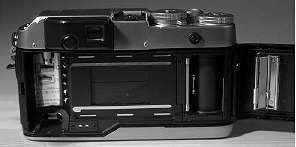
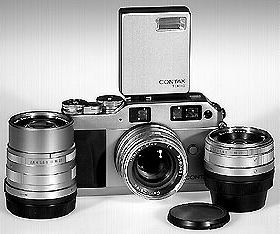 The Contax G1 is difficult to test objectively, writes David
Kilpatrick, as there is no similar camera to judge it against. It
competes with the Leica M6 but handles more like a Konica
Hexar. Some early comments from colleagues were on focusing problems
in strong contre-jour or low contrast targets. Close-up tests on 3D
objects, like a magazine page sloping away from the camera, showed
apparent errors.
The Contax G1 is difficult to test objectively, writes David
Kilpatrick, as there is no similar camera to judge it against. It
competes with the Leica M6 but handles more like a Konica
Hexar. Some early comments from colleagues were on focusing problems
in strong contre-jour or low contrast targets. Close-up tests on 3D
objects, like a magazine page sloping away from the camera, showed
apparent errors.The first problem, of poor into the light and low contrast performance, is being tackled by Contax. It is not unique to the G1, it's just that users have expected it to outperform other AF viewfinder models and match the tolerance and accuracy of SLRs. Perhaps, at the price, it should.
The second one is not a fault but a result of parallax. The viewfinder is parallax-correcting via top and left masking, as a guide to avoid cropping errors, but the finder and AF sensors do not tilt down as you focus closer; at minimum focus, the sensors are not aimed at the centre of the frame. Close-ups with the 28mm and 45mm lenses taken at 50cm have their point of focus slightly high and to the left in the frame (landscape format). To use the G1 well you need to be aware of this. This problem has never been found in traditional rangefinder cameras as they don't focus to 50cm!
The Contax G1 is so different in use from any SLR or existing rangefinder that it takes several weeks to begin to know it well. When you do, it becomes swifter than any Leica. It can be used single-handedly, and once you learn the exact location of the viewfinder eyepiece your problems end. The new user often fails to 'hit' the eyepiece when raising the camera, and has to hunt for the correct position. A week with the G1 as a constant companion, and you start to hit the spot first time.
I have now been using the G1 for almost five months - the worst five months of the year for weather and not a single vacation to make it an ideal companion - and feel comfortable with the system.
However, when buying the G1 you must be aware of its idiosyncrasies. Otherwise, you may feel frustrated or disappointed.
A better manual mode would adjust the lens via the AF motor only as the distance dial was turned, leaving it locked (this is how the Konica Hexar behaves). This would then enable quiet, real-time shooting with less battery drain. As configured there is no advantage in MF over AF, and I have ended using AF all the time.
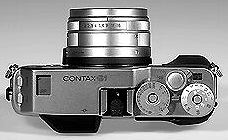 Worn on the comfortable webbing and leather neck-strap, the G1 has a
tendency to tilt backwards. The viewfinder bulge rubs you as the camera
swings. After a day of walking, this persistent presence was annoying. If
the strap lugs were slightly above and behind their position this would
not happen.
Worn on the comfortable webbing and leather neck-strap, the G1 has a
tendency to tilt backwards. The viewfinder bulge rubs you as the camera
swings. After a day of walking, this persistent presence was annoying. If
the strap lugs were slightly above and behind their position this would
not happen.My own solution has been to hold the Contax in my hand most of the time. I never feel comfortable with a valuable camera on my shoulder, as it's so easy for someone to grab it and slip it off, which is much harder with the camera round your neck. The Contax G1 is definitely a very nickable camera.

The interior track of the Contax is one of the best-designed and machined you can find in a 'compact' camera. The pressure-plate is built to Kyocera's usual standard and everything fits and works precisely.
Most people we tested could not change a lens safely without using two hands; some had to use their little finger or a long fingernail and place the camera on a table. I found that pressing the button in as far as I could often failed to release the lens. After five months of use I still do not find this easy and intend to fit a rubber pad, or something similar, to the front of the release button to make it more positive.
The 28mm needs a deep rear lens-cap. Obtain one extra one of these for working with a three-lens kit. Then the three-lens juggle of wanting to use the 90mm after the 28mm, but finding the deep cap is living on your 45mm, is eliminated. I have only one deep cap and frequently find myself trying to cap off the 28mm with a shallow one which won't fit - very frustrating!
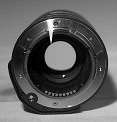 The lens mount does have a whole array of contacts, which presumably
convey focus position data, veiwfinder masking and aperture setting, and a mechanical linkage
almost identical to Minolta's AF drive. Would these contacts allow a zoom
lens? Do they also communicate (I am sure they do) with the larger Contax
TTL zoom flash units for the SLR system which also fit the G1? Would they
allow a lens with auto aperture for full program on a future body?
The lens mount does have a whole array of contacts, which presumably
convey focus position data, veiwfinder masking and aperture setting, and a mechanical linkage
almost identical to Minolta's AF drive. Would these contacts allow a zoom
lens? Do they also communicate (I am sure they do) with the larger Contax
TTL zoom flash units for the SLR system which also fit the G1? Would they
allow a lens with auto aperture for full program on a future body?
A superior arrangement could be AF windows falling either side of the viewfinder front window, with a 45mm base. The viewfinder optical path could then be 'flipped' to place the ocular to the left, making it easier to lift to the eye without hunting. The optical path of the AF system would cross the viewfinder�s. Part of the lens or hood would be seen through the finder, not uncommon even with Leicas. The G1 as designed avoids this entirely.
A 135mm lens fitted with 'spectacles' could extend the existing AF and finder optics - and we gather such a lens may be planned - but a G2 with a longer AF base would be even better.
Having said all this, I have found the AF accuracy to as good as any equivalent set of manually focused images I have taken in similar conditions.
Five months on, I still don't have any filters or hoods. I bought a nice old BDB combination hood and UV glass for �2.75 ($4) in my local camera shop, but it rather spoils the look of the G1 - it is REAL 1950s, not retro-style 1990s! (Since writing this I have seen the real Contax hood for the 90mm. It's a bummer - too short, ugly in shape, and actually looks much worse than my nice deep black plastic BDB). German firm B+W have launched a big publicity drive for their hard coated filters and introduced a 46mm size to the UK, specifically mentioning the G1 system as needing these filters.
 The late arrival - and very high price - of items which should have been
included with the system (most notably the hoods) is a pity. I could have
done without the bulky leather drawstring bags for the lenses, but can't
survive without decent lens hoods all round.
The late arrival - and very high price - of items which should have been
included with the system (most notably the hoods) is a pity. I could have
done without the bulky leather drawstring bags for the lenses, but can't
survive without decent lens hoods all round.
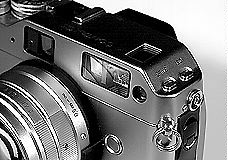
The flash PC socket is on the left-hand end, to the rear of the strap lug position, and is threaded, with a plastic cover destined to get lost. The provision of full PC-cable flash synchronisation is one of the G1's strongest points, though most users will probably opt for a dedicated hot-shoe flash.

The 18% grey shutter blinds, right, work well. The TTL meter cells read off these before the exposure is made. Landscapes with minimal sky area like the view of Abbey St Bathans kirk in Scotland, right, taken on the 90mm (conditions which call for -1 stop on most SLRs) needed only -0.5 correction. The same applied to close-ups.
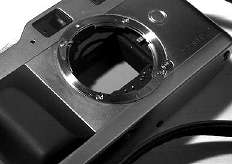 Given this, underexposure of backlit scenes or those with bright skies
might have been expected, but this didn't happen. The meter seems to read
a central area of the frame likely to produce perfect results in most
conditions.
Given this, underexposure of backlit scenes or those with bright skies
might have been expected, but this didn't happen. The meter seems to read
a central area of the frame likely to produce perfect results in most
conditions.
It also has a further lens which most will never buy in the �2,000 16mm �8 Hologon, though I can see this influencing many editorial pictures next year. The UK price of a kit is under �2,500 ($4,000) including the small flashgun, which I only checked to see if it worked, as flash goes against the way I like to use a camera like this. It works.
The optical quality of the three Carl Zeiss T-star lenses - 28mm Biogon f2.8, 45mm Planar f2 and 90mm Sonnar f2.8 - certainly rivals Leica equivalents and is superior to most 35mm SLR designs. The lack of lens-changing ease, however, meant that I switched less often than good pictures demanded. Any unsharpness is likely to be caused by focusing error at closer distances (the parallax problem) or camera shake. Exposure problems can be caused by including the sun in the frame, with a top speed of 1/2,000 setting few limits on brevity.
My experience is, however, that the success-rate of a Contax G1 used sensibly on appropriate subjects will near 100%. Don't let the close focusing fool you; rangefinders were never equal to SLRs for close-up work, and this new 'AF rangefinder' is no different.
Criticisms of the G1 in general terms are likely to be the result of failure to trust the camera, to become familiar with it, to use it appropriately and understand its strengths and weaknesses. Criticisms of fine detail, which I have had to make, only come to light when you start using the camera properly. These criticisms do not alter the unique innovation of the G1, its performance, or its value for money.